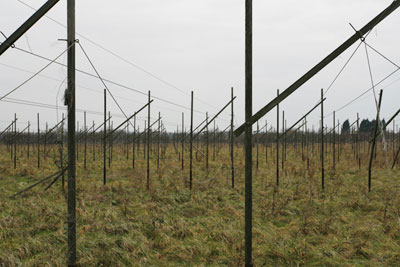![]()
![]()
![]()
![]()
...
...
.....
...
...
...
...
CERN
Flusser
Lord's Bridge
Lightning
Field
Interplanetary Scintillation Array, MRAO, 2006
[Photograph | Tim O'Riley]
One of the older telescopes at Lord’s Bridge, the Interplanetary Scintillation array (IPS) is situated in a four and a half acre field and originally consisted of 1000 wooden posts strung with more than 2000 dipoles connected by miles and miles of copper wire. With this instrument, Jocelyn Bell Burnell and Anthony Hewish discovered the first pulsar, CP1919, in late-1967.
A pulsar is an incredibly dense, rapidly spinning neutron star which emits radio pulses at regular intervals as it spins. The effect is not dissimilar to the way a lighthouse beam appears to blink periodically as it rotates in the darkness
The IPS’s cabling was routed through a small wooden shed located on the perimeter of the field. The telescope is no longer operational and the shed appears to have been left as it was when last used a number of years ago. It is home to numerous pieces of old equipment, cardboard boxes, assorted materials, a desk and chair, a pair of Wellington boots, a canvas bag hanging from a hook on the back of the door and the webs of countless spiders which reminded me of the net of wires and cables in the field outside. A piece of paper dated 1993 is pinned to the wall, stained and curled from the damp. This lists the names of observatory staff together with their call signs in Morse code.
![]()
![]()
